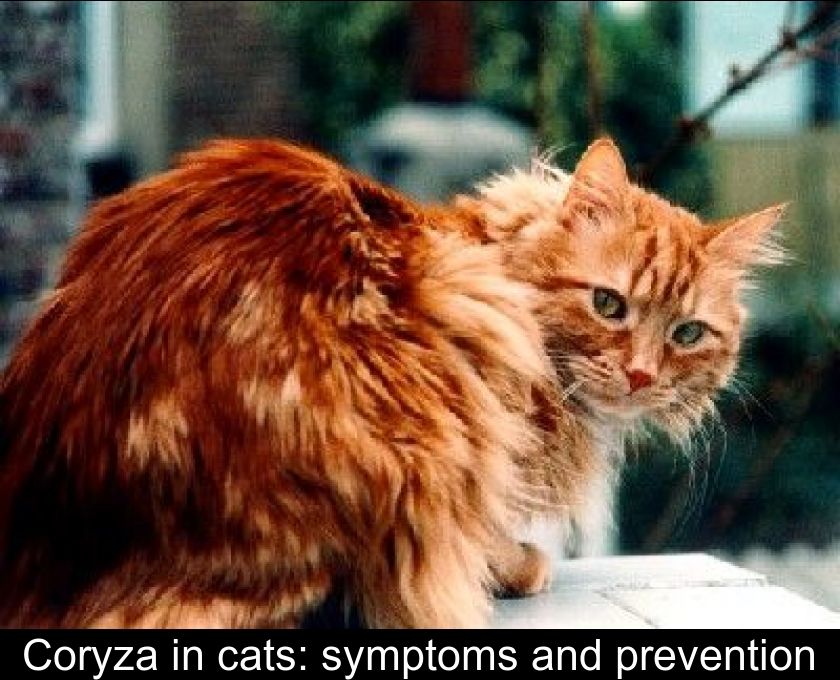Coryza In Cats: Symptoms And Prevention
Coryza in cats is a very common but not benign disease that can be fatal in unvaccinated animals. When symptoms appear, a veterinarian should be consulted immediately.
What is coryza?
Cat coryza is a disease of the respiratory system, very common in cats that live in groups and/or are not vaccinated.
It is indeed a highly contagious disease between felines (but not for humans) that is caused by a combination of several viruses and bacteria.
Three viruses are involved in coryza and cause different symptoms in the Cat:
- A 'Herpes virus' causing infection of the nose, respiratory tract and eyes (which can be fatal in weakened animals)
- a Calicivirus causing fever and fatigue, oculonasal discharge, and ulcers (red patches) in the mouth; these mouth sores cause heavy salivation and loss of appetite
- Reovirus, which causes watery eyes
The symptoms
The symptoms of cat coryza vary depending on the age of the animal and its health status.
In young cats, the disease causes coughing, sneezing, heavy discharge from the eyes and nose, conjunctivitis, and weakness of general condition (loss of appetite and fever).
In adults, coryza most often causes conjunctivitis with ulcers on the cornea.
You should consult a veterinarian if your cat sneezes, has a runny nose and salivates excessively. This disease can be serious, especially if your cat has not been vaccinated.
Note: A cat cured of coryza can remain a carrier of the disease for many years, and be contagious again following stress, parturition, or illness.
The means of prevention
The best way to prevent cat coryza is vaccination. This Vaccine works against both Calicivirus, rhinotracheitis, and Chlamydia (bacteria that can make the disease worse).
The Vaccination is done at the veterinarian's office in two injections one month apart, with a booster every year.
Note: A vaccinated animal can still get the disease, but the symptoms will be reduced.
Treatment for coryza is usually with antibiotics (tablets, drops or injections).
Everything you need to know about coryza in cats
Coryza in cats is a highly contagious disease. This disease is caused by a number of pathogens: The viruses are members of the family of Herpesvirus, Calicivirus and Reovirus.
Bacteria such as staphylococcus, streptococcus, Bordetella bronchiseptica, Pasteurella multocida and Chlamydia psittaci, a 'Rickettsia', may also be involved in the disease.
The disease takes two to four days to incubate (the time between when the cat is infected and when the first symptoms appear).
Coryza-infected cats can shed the pathogen (including Chlamydia psittaci and Calicivirus) for several months, increasing contagiousness to other cats. Moreover, the calicivirus is quite resistant to the outside environment!
If your cat does not have access to the outside world, typhus disease can spread indirectly.
When a cat develops coryza, it may show signs of: - Rhinitis, which is characterized by a runny nose and sneezing. Respiratory problems may be prevalent if the rhinitis is severe.
- Coughing
Conjunctivitis, which is characterized by red, secretory, thickened eyes. The eyeballs may sometimes be completely glued together.
- Irritation of the tongue, sometimes accompanied by ulcers. The cat drools and struggles to eat.
The disease has caused a lymph node reaction.
In this scenario, your veterinarian will advise you:
- To prevent further bacterial infections, antibiotics
- Antiviral serum, antibiotic eye drops for conjunctivitis, and L-lysine (an amino acid that boosts immunity after viral illnesses, including herpes simplex virus infection).
- Aerosol therapy (inhalation sessions) may be necessary to treat rhinitis.
These sessions can be performed at home with the cat in its carrier or at a veterinary clinic using a nebulizer: The inhalation bowl is placed in front of the grid, away from the body, and covered completely with a damp cloth. Several medications are combined and placed in boiling water in the inhalation bowl. A combination of antibiotics, medications to decrease nasal secretions, and possibly a bronchodilator will be prescribed by your veterinarian.
In some situations, especially if the animal is not eating, the cat will be sent to the hospital and placed on an IV.





